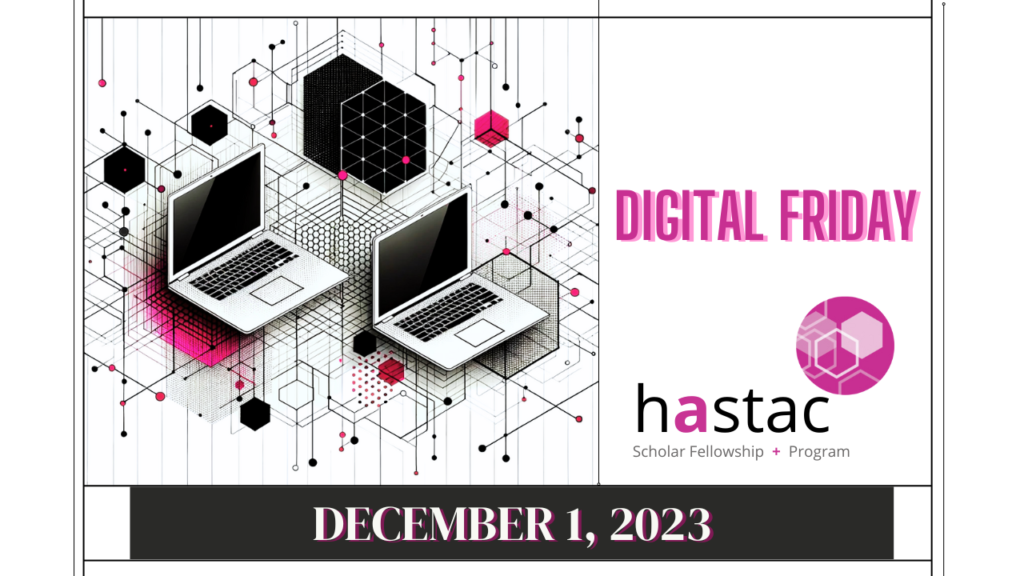Navigating New Frontiers: The Convergence of Technology and Traditional Disciplines
The Last Digital Friday of 2023, featuring HASTAC Scholars, was held on December 1st and their presentations about how technological advances are revolutionizing multiple fields was a great showcase for the convergence of technology and traditional disciplines. At this Digital Friday presentation, we hosted three HASTAC Scholars, Haoran Chang, Abby Cole and Ian Williams; while their work was from different fields and seemingly unconnected in terms of thematic material,there are strong ideas that connects them.

“Reimagining Liminal Embodiment Through Exergames”
Haoran Chang, a Ph.D. student at York University, delved into exergaming – a hybrid of exercise and gaming. Chang’s research on this topic is not merely about gaming for entertainment but a transformation of how we perceive physical activity and technology’s role in it. The integration of technology in gaming has evolved from joystick-based play to systems that encourage physical activity, demonstrating a significant shift in the interaction between users and technology.
“Re-defining Journalism as a Social Responsibility”
Similarly, Abby Cole, a Ph.D. student from the University of Texas at Dallas, offered an insightful perspective on journalism. Her focus on redefining journalism as a social responsibility in the digital age is particularly striking. In an era where misinformation is rampant, Cole argues for journalism that transcends traditional boundaries, advocating for a socially responsible approach that leverages digital platforms to uphold truth and foster social justice.
“Odds and Ends: An Autoethnographic Exploration of Obsidian for Doctoral Student Writing”
Lastly, Ian Williams’ presentation provided a compelling narrative on the impact of technology in social work and academic practices. His autoethnographic study into using technology for writing and research underlines a significant shift in academic methodologies driven by technological innovation.
What all these presentations collectively underscore is a significant trend: the necessity of historicizing technological change and its impact on the different scientific and disciplinary procedures. Research, design, and public communication have changed and will continue to adapt to accommodate these technological changes. Geographers, architects and scientists are consistently dealing with the challenges to the established traditions of their disciplines and evolve without the valuable essence of what’s important to them.
Mathew Allen’s 2012 article(1) on Internet historicity, in which he discusses how Web 2.0 brings forth a significant shift in digital culture, creating an internet culture shaped by user-generated content, social networking, and a new digital literacy. This evolution prompted a deeper reflection on the internet’s role and impact, encouraging the historicization of the web. By looking at how the internet’s uses and meanings have changed over time, scholars and users alike began to construct a narrative that contextualizes current digital practices within a broader historical framework. As a result, this historicized understanding of the internet creates a narrative that can frame the internet we are experiencing today in a historical time. This significantly changes our understanding and interaction by contrasting earlier views that treated the internet as an entirely future-orientated technology. This historicity helps us understand the internet not just as a technology or platform but as a cultural and social phenomenon that has evolved and will continue to evolve over time. Historicizing the Internet from different disciplinary backgrounds helps gain insight into its influence on interdisciplinary fields to understand how past developments mold current trends and future potentials.
“The historicity of the web must be understood cautiously: as discursive rendering that influences but does not necessarily determine each individual experience online. As Paul Ricoeur argues, the writing of history, with its emphasis on causes and consequences, and developments outside of individual experience, does not account well for the memorialised forms of the past that inform everyday life. Web 2.0 does its work in creating a past for the internet through the imposition of a particular form of understanding the present and its temporal relations with times other, through this use of versions”. (Allen,2012)
All in all, it was great to take part in the HASTAC Digital Friday and these presentations were a testament to the ever-changing face of academia where technology is not merely a tool but rather a catalyst for change. This fusion challenges traditional practices, encouraging innovation and rethinking conventional methodologies.